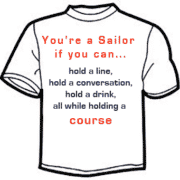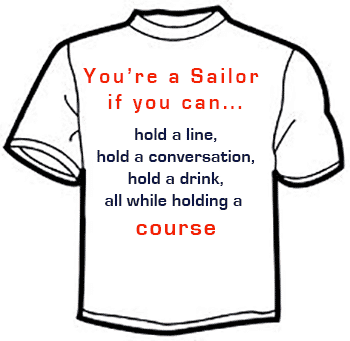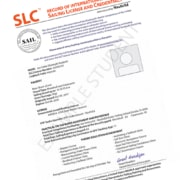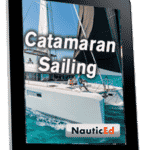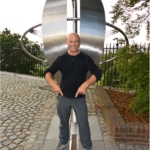How to Steer a Sailboat
Sailing the helm should be natural – like riding a bike!

What do these have in common?
This past summer I invested some serious time into having my daughter learn to ride a bike and it paid off on the last day of summer break.
It’s very sailing related so read on – no really!
Here’s what I did. I took the pedals and training wheels off and lowered the seat so that both tippy toes could touch the ground. Then on a hard surface, with a very slight incline I had her sit on the seat and push the bike along with her toes. At first when the bike tipped to one side she would put her full foot down to catch balance. After about 10 different sessions I noticed that as the bike was tipping she would automatically compensate and steer the bike to account for the tipping. I did not teach her this – it was just automatic and becoming natural. She was keeping her feet up and the bike was gliding. At about session 15 she was doing this to the point where I thought she was ready. I took her to a grassy area with a slightly bigger incline – just to account for the friction of the grass. I put on the pedals and pushed her off and AWAY SHE WENT.
The key ingredient here is automatic compensation. She did not even know she was doing it. She would automatically turn the wheel to follow the direction of her imbalance.
Helming a sailboat is exactly the same. At first you are all over the place trying to keep a straight line but as with my daughter, the more time you spend at the helm the more automatic it is going to become. This of course means more helm time more helm time and more helm time.
If you need more helm time but don’t own a boat read this post about gaining experience on a sailboat.
I was speaking to my friend Robert Barlow at Texas Sailing Academy in Austin Texas yesterday. Robert is an excellent sailing instructor. He described a similar thing when he teaches. We were both talking about how students get distracted by the wind meter and the wind vane and the sails and waves and boats and… which keeps getting them off course. All we want the student to learn at first is to feel the boat and react accordingly to keep the boat sailing in a straight line – towards a distance house or tree on land as a reference. What Robert does is to blind fold the student so that they have to rely on their senses.
Some of the senses are:
- Boat heeling more or less
- Hearing the wind direction over your ears
- Hearing the flapping of sails
- Feeling pressure on the helm
All of these give an indication that something is happening requiring an adjustment.
BUT the big trick is to get to a point where the information by passes your brain and goes directly to your hand. Not really – your brain still does the processing, but assigns less and less processing power to the required action – like the riding the bike scenario. How much processing power does your brain assign to needing to turn the wheel to stay balanced. If it required any of the main Ram to stop and think – “Oh I am falling – now which way should I turn the wheel to make me stay up – um let me see if I turn to the right the bike will do ummm that or left it will do this – ok left it is”. No that doesn’t happen.
Back to sailing. We need to get to a point where if the boat say heels due to a wind gust then the HAND automatically adjusts the helm to compensate the boat wanting to turn upwind. You hand just goes into automatic mode and prevents that by turning the boat down wind WITH OUT THINKING. Your senses hear the sail flapping – your HAND turns the boat down wind. Your ears sense more wind in your upwind ear, your HAND turns the boat upwind.
It is like your hand is doing the processing not your brain. This point is well proven possible by the bike scenario.
A few months back I was out riding my mountain bike. I was angling towards a tiny rock ledge no more than 3 inches high. If the front wheel takes on that ledge, the ledge will win. It’s simple physics a force to the left at the bottom of the bike near the ground opposing my momentum centered 4 feet off the ground will create a tipping moment. One that quickly ends in the middle of a cactus in Texas. None of these thoughts went consciously through my brain as my eyes delivered the information. My right leg mashed the pedal down, both arms pulled and my back muscles tensed to shift my weight back – all automatically and in the correct timing to lift the tire up over the ledge. Having completed that maneuver the arms swung to miss a rock and so on. At the next water break I stopped and thought about that and said WOW – that brain process is cool. Any neuroscientist sailors care to pop me an email to explain this? – I’ll post it as a comment here. How does the brain assign the processing power initially at a conscious level then pass it down to the subconscious. Even years later, the subconscious remains – ridden a bike lately? It’s still easy.
Back to sailing. And this is a note to instructors and to captains teaching crew members to helm. Be conscious of the subconscious.Try to help your student move that reactionary process to the subconscious so that the “hand” is doing the processing not the brain. If you are thinking about it – you just need more helm time.
I always say:
Cheers
Grant Headifen
Director of Education
Congrats Alexandra on your first ride without the training wheels.
Take the NauticEd Skipper Course now. A beginner to intermediate sailing course. Log time in our free online sailors logbook and begin to earn your sailing certification accepted by yacht charter companies worldwide. Signin/signup for free now.
- RYA Day Skipper with NauticEd - April 1, 2024
- NauticEd uses the SailTies GPS Tracking App - March 29, 2024
- Sea of Cortez Flotilla – February 2025 - March 8, 2024

